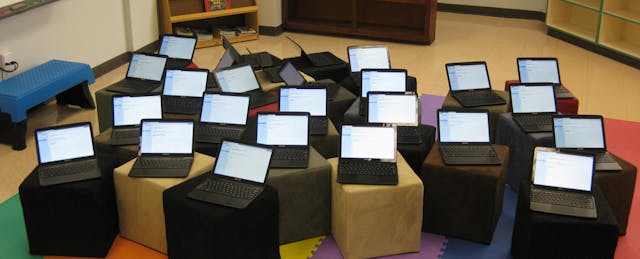Chromebooks, which began as cheap netbooks that required Internet and raised eyebrows, have now become a bargain for many schools, especially as educational tools increasingly move to the cloud. They made up almost half of the 3.9 million devices shipped to the US K-12 market from April through June 2015.
According to market research firm Futuresource Consulting, 1.9 million Chromebooks were sold to the US K-12 schools during this period, with Dell replacing Acer as the leading supplier. Tablets, still dominated by Apple iPads, accounted for 1.1 million units. And notebooks—which include Apple Macbooks and Windows laptops—made up 880,000 device shipments.
A key advantage for Google’s Chromebooks has been its low price point. “With Chrome, you’ve seen this massive surge in the $300 and below category, and it comes at a time when schools are moving towards online assessments,” says Mike Fisher, Associate Director of the Education Division at Futuresource. And Chromebooks continue to get cheaper; new models recently announced by Haier and HiSense start at $149.

The success of Chromebooks has dramatically changed expectations about entry-level price points for school devices, explains Fisher. In the first half of 2015, 52 percent of devices sold in the US education market were under $300—a significant increase from 2013 when only 25 percent of devices were sold at this price range.
Fisher says that’s been troublesome for incumbent suppliers like Microsoft, which previously dominated the education market with computers in the $400 price range. Apple’s position is also slipping. Adds Fisher, after the “rush to buy iPads in 2011 to 2013, sales have been flat for the past two years.”
Expect stiffer price competition later this year. Microsoft has been reportedly working on a $149 Windows laptop that some have called a “Chromebook killer.” And Apple’s lowest-end tablet, the iPad mini 2, currently retails at $259.

For schools, what may just be as important as price are the unique services that come with the device. Google has effectively tied Chromebooks’ education users to the company’s suite of productivity tools, an education app store and its own lightweight learning management system, all while offering a robust device management console. Microsoft is following similar steps with a dashboard that syncs with different Microsoft Office apps. And Apple is working with IBM on a “Student Achievement App.”
By the end of the year, Futuresource estimates that 11.3 million devices will be sold in the US K-12 education market—a 23 percent increase over 2014. “There’s going to be a bloody fight in the market” for low-end devices, says Fisher.


